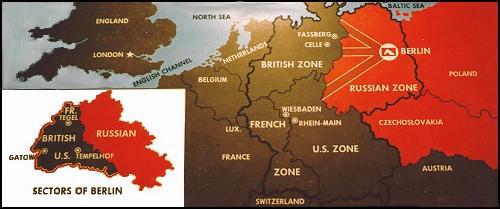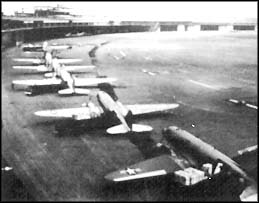

BERLIN AIRLIFT
|
June 1948 The first major test of the Free World's will to resist Soviet aggression came in June 1948 when Soviet authorities, claiming "Technical difficulties," halted all traffic by land and by water into or out of the western-controlled section of Berlin. The only remaining access routes into the city were three 20 mile-wide air corridors across the Russian zone of Germany. Faced with the choice of abandoning the city or attempting to supply its inhabitants with the necessities of life by air, the Western Powers chose the latter course and for the next 11 months sustained the city's 2 1/2 million residents in one of the greatest feats in aviation history. Operation Vittles, as the airlift was unofficially named, began on June 26 when USAF C-47s carried 80 tons offood into Berlin, far less than the estimated 4,500 tons of food, coal, and other material needed daily to maintain a minimum level of existence. |
 |
 |
But this force was soon augmented by U.S. Navy and Royal Air Force cargo aircraft. On Oct. 15, 1948 to promote increased safety and cooperation between the separate U.S.and British airlift efforts, the Allies created a unified command, theCombined Airlift Task Force under Maj. Gen. William H. Tunner, USAF. To underscore Allied determination to resist Soviet pressure, three SAC bomb groups were sent to Europe, placing Soviet targets well within B-29 range. Airlift aircraft used three airfields within Berlin: Tempelhof (above) in the U.S. sector, Gatow in the British sector, and Tegel which was built in the French sector in only 60 days using volunteer German men and women laborers. C-47s unloading at Tempelhof, formed the nucleus of the airlift until September when the larger and faster four-engine C-54s capable of hauling ten tons had been put into service.Cross-sectional view of flight into Berlin as of Sep. 1948.This arrangement allowed for landing at the rate of one plane every 3 minutes. Later, two levels were used with spacing that allowed for landing at the same rate. Airlift pilots flew under an extremely rigid system of traffic control, which required each pilot to fly an exact route at predetermined speed and altitude. |
If an arriving plane was unable to make a landing at Berlin on its first attempt, it had to return to its base in West Germany. Adding to the routine dangers facing airlift pilots was Soviet harassment in the form of jamming radio channels, directing searchlights at aircraft taking off at night, the "buzzing" of cargo planes by Russian fighters, and barrage balloons allowed to drift into the air corridors. At midnight on May 12, 1949, the Soviets reopened land and water routes into Berlin. However, airlift continued until September 30 to build a backlog of supplies. The Allied airlift had saved Berlin from Soviet takeover and had taught valuable lessons in air traffic control, aircraft maintenance, standardized loading and unloading procedures, and other aspects of sustained mass movement of cargo by air. Cost of the effort in human lives totaled more than 65 U.S., British, and German personnel, including 31 Americans.
| ŠAvStop Online Magazine Contact Us Return To News |